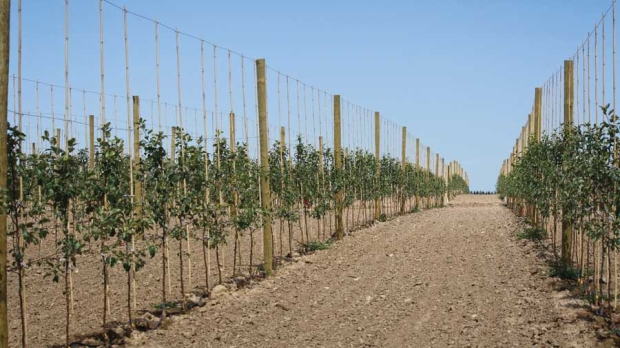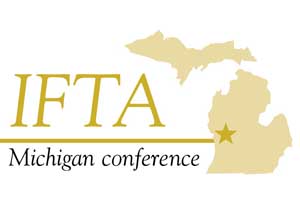
Shown a few months after it was planted in the spring of 2013, this high-density tall spindle orchard near Grand Rapids, Michigan, uses a drip-irrigation system.
Richard Lehnert/Good Fruit Grower
Growers in the Eastern United States, with rain aplenty, once thought irrigation was just for their arid colleagues out West.
Not any more.
Today, with the push for high-density, precision orchards on shallower roots, growers in Michigan, New York and Pennsylvania more and more consider irrigation a must.
“Technically, it’s not needed in the East, but if you want to be the best and minimize risk, it is,” said Brett Anderson of Anderson Brothers Orchards in Sparta, Michigan.
 Irrigation was a hot topic at the International Fruit Tree Association conference in February in Grand Rapids, Michigan. Several speakers called water control a crucial tool in spite of ample precipitation.
Irrigation was a hot topic at the International Fruit Tree Association conference in February in Grand Rapids, Michigan. Several speakers called water control a crucial tool in spite of ample precipitation.
“We don’t grow fruit in a desert,” Anderson told growers at the conference.
For example, Grand Rapids receives 37 inches of rain every year. The desert hills of Wenatchee, Washington, get only 9 inches.
But if growers want to bump fruit quality from fancy to extra fancy and increase their size, irrigation will pay off quickly in the East, Anderson said.
A drip irrigation system may cost an average of $2,000 per acre, but just a 10 percent boost in yield could mean $1,000 extra in profit per acre in one year alone, he said.
He recalls in 2008, the year after a dry summer, talking with consulting customers who complained their crop didn’t set as well as their neighbors. By and large, those customers lacked irrigation.
“The one factor I saw was irrigation,” he said.
Researchers in the East have been trying to convince growers of the necessity of irrigation for decades, said Ron Perry, professor of horticulture at Michigan State University.
“We keep telling the growers it’s necessary,” he said. “A lot of them don’t think so, and then they don’t get the return bloom.”
It’s most important in the northern part of the state, where soil is sandy, he said.
Perry estimates that about 40 percent of tart cherry growers and more than half the grape growers in northwest Michigan use micro-irrigation. Southern Michigan apple growers, with fewer high-density orchards, more easily get away without it, he said.
Perry recalls trials from 1984 that showed irrigation brought a 20 percent to 25 percent increase in yield and return bloom and a 15 percent to 20 percent increase in fruit size.
Irrigation is becoming more important in the East as growers switch to high-density trees on dwarfing rootstocks with shallower root zones, Alan Lakso of Cornell University told growers at the IFTA conference.
To help them, researchers have developed a mathematical irrigation model specific to apples in Eastern climates, because Western guidelines don’t always add up, Lakso said.
Irrigation models normally use the Penman-Monteith equation, which estimates the effects of weather on plant water loss, using the water use of grass as a baseline.
Modelers then assume their plant — in this case an apple tree — uses a consistent fraction of that amount, called a crop coefficient.
That seemed to work in desert climates such as eastern Washington and California’s Central Valley, but not so well in upstate New York, he said.
Using the new Cornell model, trials in the Hudson Valley of New York showed a decrease in fruit stress and increase in fruit size compared to no irrigation, Lakso said.
Lakso and his colleagues have posted the tool online in conjunction with the Northeast Regional Climate Center. It asks growers to choose a nearby weather station and then input some specifics about the orchard, such as the age of the trees, to receive irrigation information. •
– by Ross Courtney
More Information:
The Cornell University apple-specific irrigation model can be found at newa.nrcc.cornell.edu/newaTools/apple_et.
Correction: An earlier version of this story incorrectly spelled Alan Lakso’s last name. Good Fruit Grower regrets the error.






Leave A Comment